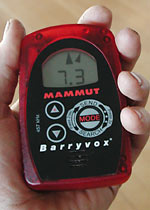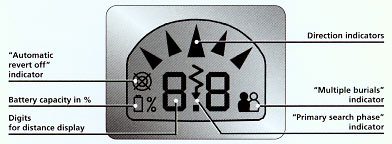Shop for Mammut Barryvox avalanche transceivers
(Please note: Manufacturing of this beacon has been discontinued, this review is curated in publication for historical continuity.)
Have you ever seen a snow avalanche? Ever been caught in one? I can testify that if you’re swept away by anything but the smallest slide, your avalanche beacon is of little concern compared to your tearing ligaments and snapping bones. Nonetheless, if you are buried alive in the white tomb, wearing a beacon is the only thing that gives you any chance of being dug out alive. Thus, it’s gear you should never be without.

Front view of the Barryvox. LCD showing search mode. Clean design — easy to wear.
Since it is an essential gear for backcountry skiers — but seldom used for anything but practice — the ideal avalanche beacon should be tiny, lightweight, and easy to carry.
Sadly, many avalanche beacons vary in size from chunky to huge. One unit, however, defies the norm.
Last winter I joined up with Andrew McLean for a few days of Wasatch ski touring in the legendary Utah powder, and noticed he used a little red unit called a Barryvox. Emphasis on the word “little.” I always pay attention to what gear Andrew uses in the backcountry, as everything he carries is the optimum for max vertical and high performance.
With a bow to Andrew I acquired a Barryvox this year, and used it enough for a thorough evaluation.
When I pulled the Barryvox out of the brown mail-order box, I was stunned by Mammut’s beautiful job of retail packaging. The unit is mounted in a protective cardboard box, decorated with high-quality graphics including a soulful black and white photo on the inside of the lid (gift givers take note — this simply reeks of quality). Humor is also included — I got a laugh out of the packaging when I noticed their slogan: “Attention: equipment can save your life.” Talk about stating the obvious…
The quality of the Barryvox goes on and on. Instead of one thick manual you have to dig through to find the English section, it comes with five separate manuals to cover the major languages. Spanish is missing — is that a Swiss thing?

Back of Mammut Barryvox circa 2006, at this time the most compact beacon on the market.
The form factor of the Barryvox is equally beautiful. As any tool should, it fits in your hand like it grew there. It measures about 2 5/8 inches wide by 4 1/4 inches long, x 7/8 inch thick, easily smaller than most other units of equal function and quality. It weighs in at 5.9 ounces (with batteries), a few tenths of an ounce less than a Pieps 457, and significantly lighter than many other units on the market. The translucent case reveals the inner workings — this is aesthetically pleasing and also practical, as it shows that batteries are installed, and allows the flashing LED to radiate from almost everywhere in the case. Even the harness is surprisingly elegant: it allows quick removal of the beacon from a holster so you can search with it, and is much less obtrusive than than the bulky contraptions you’ll frequently find on other beacons.
Okay, how about performance? In my backcountry life I want simple things from my beacon. I want the batteries to last; it should be easy to switch on and off; if it’s digital it should allow what’s pretty much point-and-shoot searching; switching between transmit and receive should be obvious and easy. I give the Barryvox a big thumbs-up on all of the above.
Back of the Barryvox. The translucent case reveals the batteries, and is inscribed with a series of reminders that make sense once you’ve practiced a bit.
When you turn the unit on, a graphic display tells you the estimated battery power you have remaining — very nice. If you’ve got less than 20%, an acoustic alarm gives you the heads up. I left the unit on at home and got about 9 days of around-the-clock continuous transmit from a set of alkalines. So a fresh set of alkaline batteries in the Barryvox should last for several weeks of daily use in transmit mode (provided you turn it off at night). Switching to search mode uses more battery power, so if you practice much, expect less life from the batteries.
The Barryvox uses 3 AAA batteries, a concern for me since almost all my other backcountry electronics uses AA cells. With all my AA cell gear I depend on swapping batteries between devices if I need spares — add AAA cells into the mix and I can end up without spares. My solution to this is to get more devices that use AAA cells, and to carry 3 spare AAA cells in my repair kit. I now have a headlamp that uses AAAs, and when I upgrade my 2-way-radio the new one will probably use them as well. (For tips about batteries, please see my battery article.)
I like the Barryvox on-off switch. It’s an obvious green tab that sticks out from the edge of the unit when it’s off. A small détente button keeps it from getting switched accidentally. I believe the way to use a beacon is to switch it on and off at home, and leave it on all day. Thus, working the switch with gloves is a non-issue for me. Even so, I tested the Barryvox switch with a bulky pair of gloves and was still able to use it.
What about when the rubber meets the road, or the avalanche hits the runout zone? For avalanche search and rescue the Barryvox works in both digital and analog mode, and the modes are pretty much automated. If it senses a weak signal at the start of a search, it starts in analog mode so it has more sensitivity and picks up a signal sooner. As you get closer to the buried beacon, the search beacon switches to digital mode, the LCD shows direction arrows, and you follow the arrows to the victim. (Incidentally, whenever the display is on, it is backlit enough for easy viewing in dim light or darkness.)
When you get close, the beacon switches to a pinpoint location mode. You hold it just above the snow surface, move it back and forth, then dig where the distance indicator shows the smallest number. I found the pinpoint part of the search to be a bit confusing at first, but it made sense after I practiced a few times. This brings up a point: While these “point-and-shoot” digital beacons could possibly be used by a never-ever novice to locate a buried victim, a small amount of practice is essential for any kind of reliable results. I know guides who simply hand their client a digital beacon, show them how to change to search mode, and that’s it. Bad idea. At least do one short practice session.

Barryvox LCD display. The indicators are functional and intuitive.
The Barryvox switches to a computerized multiple burial mode if it hears more than one signal. This multiple mode is sophisticated and functional, though it requires practice to use reliably. I’m not particularly excited about this feature, as I feel the only viable avalanche safety protocol is to expose one person at a time to hazard, and multiple burial mode implies disregard for this basic principal. But that’s in a perfect world. Route finding does sometimes get messy, and you end up with more than one person in the shooting gallery. Also, economics and guided trip dynamics dictate that commercial guide services may place more than one person at a time onto avalanche slopes. (Recent tragic events illustrate this — and hopefully will make this practice less popular.)
I love the “Personal Settings” function of the Barryvox computer. By punching a few buttons you can change things such as the way the speaker works and the automatic revert to transmit time (ARTX). Speaking of this, It’s said that during certain multiple burial tragedies, the ARTX mode on various beacons caused confusion during the rescue (aka body recovery). I don’t doubt this, and would suggest setting this function to its longest time of 8 minutes. Practice using the personal settings mode so you can set this to a shorter time in case you get involved in a rescue where you are exposed to avalanches that might come down on the rescue site. The personal settings allow you to disable ARTX, I don’t recommend doing so, as this function is a fail-safe in the event the beacon is mistakenly left in receive/search mode, or switched accidentally. By the same token, always do your practice searches with ARTX enabled, as the warning tone and subsequent automatic switch to transmit can be mighty confusing (it switches back to search mode when you hit any button, but real life panic may obviate such simplicity.)
As for downsides, I tried hard to find something kludgy about this unit, but I failed. It works, it’s small, and the quality is superb.
But this is a gear review, so I have to find something to whine about. Try this. It’s time for convergence: I’m tired of carrying a camera, beacon, headlamp, 2-way radio, walkman, watch, cell phone and who knows what else. The Barryvox has a headphone jack, why not build an MP3 player into the thing? And don’t stop there. How about watch and altimeter functions? After that, why not go whole hog and build a 2-way radio into it, as well as a digital camera? I’m waiting — but in the meantime the little Barry is still my favorite avy beacon.
Shop for Mammut Barryvox avalanche transceivers
WildSnow.com publisher emeritus and founder Lou (Louis Dawson) has a 50+ years career in climbing, backcountry skiing and ski mountaineering. He was the first person in history to ski down all 54 Colorado 14,000-foot peaks, has authored numerous books about about backcountry skiing, and has skied from the summit of Denali in Alaska, North America’s highest mountain.
